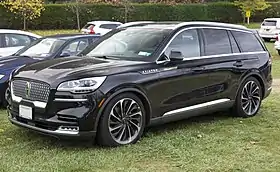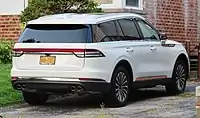Lincoln Aviator
The Lincoln Aviator is a three-row mid-size luxury SUV[3] marketed and sold by the Lincoln brand of Ford Motor Company. One of four SUVs offered by Lincoln, the Aviator is currently in its second generation, slotted between the Lincoln Nautilus and Lincoln Navigator in size.
| Lincoln Aviator | |
|---|---|
 2020 Lincoln Aviator | |
| Overview | |
| Manufacturer | Lincoln |
| Production |
|
| Model years |
|
| Body and chassis | |
| Class |
|
| Body style | 5-door SUV |
| Layout | |
The first generation of the Aviator was produced from the 2003 to 2005 model years as a rebadged version of the Mercury Mountaineer (itself based on the Ford Explorer); following the Lincoln Versailles and Lincoln Blackwood pickup truck, the Aviator was one of the shortest-produced vehicles ever sold by Lincoln. For the 2007 model year, Lincoln expanded its use of crossover SUVs; the five-passenger MKX offered a similar exterior footprint while the MKT (introduced in 2009) offered the three-row seating of the Aviator.
For the 2020 model year, the Aviator made its return to the Lincoln model line (again based on the Ford Explorer).[4][5] For the first time in a Lincoln-brand vehicle, the Aviator is offered as a plug-in hybrid.
The first-generation Aviator was assembled at the now-closed St. Louis Assembly in Hazelwood, Missouri alongside the Explorer and Mountaineer. The second-generation Aviator is assembled at Chicago Assembly in Chicago, Illinois alongside the Explorer and the Ford Police Interceptor Utility.
First generation (UN152; 2003)
| First generation (UN152) | |
|---|---|
 | |
| Overview | |
| Production | 2002–2005 |
| Model years | 2003–2005 |
| Assembly | United States: Hazelwood, Missouri (St. Louis Assembly) |
| Body and chassis | |
| Platform | Ford U1 platform |
| Related | |
| Powertrain | |
| Engine | 4.6 L Modular V8 (gasoline) |
| Power output | 225 kW (302 hp; 306 PS) |
| Transmission | 5-speed 5R55S overdrive automatic |
| Dimensions | |
| Wheelbase | 2,888 mm (113.7 in) |
| Length | 4,910 mm (193.3 in) |
| Width | 1,877 mm (73.9 in) |
| Height | 1,826 mm (71.9 in) |
| Chronology | |
| Successor |
|
The Aviator was launched for 2003 model year, slotted below the Navigator. As with the Explorer and Mountaineer, a three-row seating configuration was standard; in contrast to the Explorer and Mountaineer, a six-passenger configuration was standard, with bucket seats and a center console in the second row (a second-row bench seat was available as a no-cost option).
Alongside the choice of four-wheel-drive drivetrain configuration and towing packages, the Aviator was offered with relatively few options. In addition to all the standard features, options included heated/cooled front bucket seats, xenon (HID) headlights, 17-inch chrome wheels and a DVD based navigation system. These options were late availability in 2003 on the premium model and 2004 (Ultimate), 2005 (Elite). Shared with the Mountaineer, the Aviator was equipped with dual front/side airbags, side curtain airbags, along with stability and traction control.
Chassis
Sharing its chassis with the third generation Explorer, the Aviator is derived from the body-on-frame Ford U1 platform. Sharing its 2,888 mm (113.7 in) wheelbase with the Explorer/Mountaineer, the Aviator is fitted with four-wheel independent suspension.
A standard towing package was fitted to all AWD Aviators with a heavy-duty towing package optional on either RWD or AWD models.
Powertrain
In place of the SOHC 2-valve version of the 4.6 L Modular V8 shared with the Explorer/Mountaineer and other Ford trucks, the Aviator was fitted with the DOHC 4-valve version of the engine, shared with the Mustang Mach 1 and Marauder.
Producing 225 kW (302 hp; 306 PS) and 407 N⋅m (300 lbf⋅ft) of torque, the DOHC V8 engine in the Aviator came with two more horsepower than the 5.4 L V8 in the Navigator (though with 75 N⋅m (55 lbf⋅ft) less of torque). As with the Explorer/Mountaineer, rear-wheel-drive was standard, with Lincoln offering all-wheel-drive as an option; all versions were equipped with a 5-speed 5R55S overdrive automatic transmission.
Body
As with the Mountaineer, the Aviator derived its body construction from the third generation Explorer, sharing its body structure, doors, and roofline with both model lines. The Aviator adopts a number of styling cues from the second generation Navigator which gave it the nickname "The Baby Navigator", with visually similar front and rear fascias, lower door panels/running boards, grilles and headlamps, and license plate surrounds. The Aviator was styled with a Lincoln-specific dashboard, adopting a design nearly identical to the Navigator. Styled similar to later-1960s Lincolns, the rectangular-designed dashboard of both models featured an instrument cluster with electroluminescent gauges and needles. The primary visual difference between an Aviator and a Navigator is the lettering on the radio cover panel; an Aviator is lettered "LINCOLN", with its Navigator counterpart lettered "NAVIGATOR". As with the Navigator, the Aviator was given model-specific seats and leather, with American walnut wood trim on the doors and steering wheel.
Trim
At its 2002 launch, the Aviator followed the trim nomenclature of the LS and Navigator, with a Luxury base trim and Premium top-level trim. For 2004, the Premium trim was renamed Ultimate, matching the Navigator and Town Car. For 2005, the Luxury trim became the sole offering, with previous content remaining available as stand-alone options, including a rear-seat DVD player. An Elite option package was offered, which bundled all features of the Premium/Ultimate trims; the package offered a DVD-based navigation system.
Kitty Hawk Special Edition
To commemorate the 100th anniversary of the Wright Brothers' 1903 flight at Kitty Hawk, North Carolina, and the 100th anniversary of Ford Motor Company, Lincoln created a "Kitty Hawk" limited edition of the Aviator; it was the official vehicle of the 2003 EAA Countdown to Kitty Hawk. Along with special Kitty Hawk badging and trim, the limited-edition vehicles were fitted with special wood trim which is mink zebrano, argent painted and chrome grille, and a rear spoiler, chrome exhaust tip, chrome wheels, xenon (HID) headlamps, black premium leather heated/cooled seats with Kitty Hawk logo embossed on front seat backs, black carpet floor mats with stitched Kitty Hawk logo, available only in black exterior color.[6]
Marketing and reception
Lincoln played up the similarity to the Navigator full-size SUV with magazine ads that read, "Imitation is the sincerest form of flattery. Especially when it's yourself you're imitating." The Aviator seemed to have been met with relatively positive press coverage.[7]
While the Aviator's styling borrowed cues from its big brother, the Navigator, it also looked similar to the very widespread Explorer with which it shared the platform. Also working against the Aviator was it was priced similar to the larger and relatively popular Expedition. Car and Driver magazine said in a comparison test, in which the Aviator tied for fifth place, that only the car's high price and lack of certain features and no low range with the 4WD model held it out of contention for the top spots.[8]
 2005 Lincoln Aviator
2005 Lincoln Aviator 2004–2005 Lincoln Aviator, rear ¾
2004–2005 Lincoln Aviator, rear ¾ 2003 Lincoln Aviator (US)
2003 Lincoln Aviator (US)
Replacement
Coinciding with the model cycle of the Ford Explorer, the first-generation Lincoln Aviator was discontinued after the 2005 model year, with the final vehicle produced by St. Louis Assembly on August 19, 2005. At the 2004 Detroit Auto Show, Lincoln previewed an intended second generation of the Aviator. In a break from the Explorer/Mountaineer, the model line was shift its design from a three-row SUV to a two-row crossover SUV, becoming a Lincoln counterpart of the Ford Edge CUV. The second-generation Aviator was to skip the 2006 model year entirely, released as an early 2007 vehicle.
During 2007, Lincoln phased in a rebranding of its model line, adopting a "MK" model nomenclature for all vehicles (with the exception of the Navigator and the Town Car). The Aviator nameplate was dropped, becoming the Lincoln MKX (X= crossover); based on the Ford CD3 platform, the production MKX served as a counterpart of the Ford Edge.
Second generation (U611; 2020)
| Second generation (U611) | |
|---|---|
 | |
| Overview | |
| Production | May 6, 2019–present [9] |
| Model years | 2020–present |
| Assembly | United States: Chicago, Illinois (Chicago Assembly) China: Chongqing (Changan Ford)[10] |
| Body and chassis | |
| Platform | Ford CD6 platform |
| Related | Ford Explorer |
| Powertrain | |
| Engine | 3.0 L twin-turbocharged EcoBoost V6 (gasoline) |
| Power output | 298–368.4 kW (400–494 hp; 405–501 PS) and 470–630 lb⋅ft (640–850 N⋅m) torque |
| Transmission | Ford 10R80 10-speed automatic |
| Dimensions | |
| Wheelbase | 3,025 mm (119.1 in) |
| Length | 5,062 mm (199.3 in) |
| Width | 2,022 mm (79.6 in) |
| Height | 1,768 mm (69.6 in) |
| Chronology | |
| Predecessor | Lincoln MKT (2010–2019) |
At the 2018 New York Auto Show, Lincoln unveiled a prototype version of its planned second generation Aviator, slated to enter production in 2019.[4][5] While not officially announced as a replacement for the MKT, the Aviator is marketed above the Nautilus and below the standard-wheelbase Navigator.
A more detailed production was later introduced at the Los Angeles Auto Show on November 28, 2018. Lincoln confirmed that the Aviator will go on sale in the summer of 2019 as a 2020 model in North America and in China afterwards. Lincoln notes that it will be marketed as a mid-size SUV.[11]
With 494 horsepower and 630 lb-ft of torque, and all of the power and torque coming from a 3.0-liter twin-turbocharged V6 with a hybrid system, the Aviator Hybrid's output makes it on par with likes of other midsize performance SUVs such as the BMW X5 xDrive 50i (456 hp and 479 lb-ft), and the Porsche Cayenne E-Hybrid (455 hp and 516 lb-ft).
Vehicle overview
The 2018 Aviator prototype marked the debut of an all-new vehicle platform for Ford Motor Company; while the vehicle is rear-wheel-drive, the architecture is designed for multiple powertrain layouts, including all-wheel-drive and front-wheel-drive.[4] The second generation Aviator shares its platform architecture with the sixth generation Explorer.[4][5] While again mechanically related to the Explorer, the Aviator will be given its own body design.[4] Adopting design cues from the Continental and Navigator, the Aviator adopted conservative exterior styling, to contrast from a "visual attack" (seen on competing vehicles).[4]
No specific engine or transmission details were announced as part of the unveiling; the production Aviator will offer plug-in hybrid (PHEV) capability as an option, the first Lincoln vehicle to do so.[4][1]
Making their way into the production vehicle, several technology features made their debut on the 2018 prototype Aviator.[4][1] Tying the vehicle camera system with the continuously controlled dampers, Suspension Preview Technology looks at the road ahead for surface irregularities (i.e., potholes), preparing the suspension for impact and its effect on vehicle ride. Phone as a Key allows an Aviator to be driven without keys; the technology allows the smartphone of the owner to serve as the vehicle key fob, with the door-mounted keyless entry keypad allowing access in the event of phone battery failure (the interior is designed with wireless charging for smartphones).[12]
A number of safety technology features are included, with Lincoln CoPilot360 packaging automatic emergency braking with pedestrian detection, a blind-spot information system with cross-traffic alert, lane keeping system, lane centering,[13] reverse camera, and auto high-beams. Reverse Brake Assist applies the brakes if the vehicle detects an object when the transmission is in reverse.[4][12]
Lincoln designers worked with the Detroit Symphony Orchestra to compose 25 unique sound effects to be used for the door chime and other indicator alerts for the Aviator.[14]
 Rear view
Rear view
Sales
| Calendar Year | American sales |
|---|---|
| 2002[15] | 1,856 |
| 2003 | 29,517 |
| 2004[16] | 23,644 |
| 2005 | 15,873 |
| 2006[17] | 1,711 |
| 2019[18] | 8,323 |
| 2020[19] | 23,080 |
References
- “Lincoln Aviator debuts as stylish 3-row crossover with a surprise” from Autoblog (March 28, 2018)
- https://www.caranddriver.com/news/a25326730/2020-lincoln-aviator-photos-info/
- ZumMallen, Ryan (2020-10-16). "Lincoln Aviator Prices, Reviews, and Pictures | Edmunds". Edmunds.com.
- "Lincoln Aviator Concept First Look: SUV is Back on New Rear-Drive Platform - Motor Trend". Motor Trend. 2018-03-27. Retrieved 2018-04-01.
- “Lincoln amps up design with Aviator reboot” from The Detroit News (March 28, 2019)
- http://www.prnewswire.com/news-releases/lincoln-aviator-kitty-hawk-edition-celebrates-100-years-of-flight-74706312.html
- "Lincoln's derailed gravy train hitches to another car." Archived 2007-09-29 at the Wayback Machine Car and Driver, December 2002.
- "The Bradsher Bunch", Car and Driver, January 2003.
- https://www.donlen.com/buildstart-trucks-ford.html
- "Lincoln Aviator China Sales Figures". Carsalesbase. Retrieved 2020-10-21.
- "2020 Lincoln Aviator crossover is a hot rod with 400 horsepower standard" from Autoblog (November 28, 2018)
- "Elegant Aviator SUV Previews Lincoln's Next Act with Power, Technology and Plug-In Hybrid Option | Lincoln Media Center". media.lincoln.com. Retrieved 2018-04-01.
- "2020 Lincoln Aviator Finally La-La-Lands in Production Form in L.A." cars.com. Retrieved 28 November 2018.
- Abuelsamid, Sam (November 5, 2018). "2020 Lincoln Aviator Debuting At LA Auto Show With Custom Symphonic Tones". Forbes. Retrieved November 5, 2018.
- "Ford's F-Series Truck Caps 22nd Year in a Row as America's Best-Selling Vehicle With a December Sales Record". Theautochannel.com. 2004-11-17. Retrieved 2009-04-28.
- "Ford Achieves First Car Sales Increase Since 1999". Theautochannel.com. 2004-11-17. Retrieved 2009-04-28.
- "Ford Motor Company 2007 sales". January 3, 2008. Archived from the original on February 12, 2009.
- "F-Series Hits 43rd Straight Year as America's Best-Selling Pickup; Ford Achieves 10 Straight Years of Leadership as America's Best-Selling Brand; Lincoln SUV Sales Best in 16 Years". media.ford.com. 2020-01-06. Retrieved 2020-01-06.
- "Truck Customers Make F-Series America's Best-Selling Pickup For 44 Straight Years; Ford Brand Achieves 11 Straight Years as America's Best-Selling Brand; Ford Explorer Claims Top Spot in 2020; Luxury Customers Propel Lincoln SUVs to Highest Sales in 17 Years". Ford Media Center. Retrieved 8 January 2021.